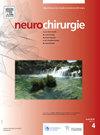Endoscopic transorbital approach for orbital cavernous hemangioma: A case series
IF 1.4
4区 医学
Q4 CLINICAL NEUROLOGY
引用次数: 0
Abstract
Background
Orbital cavernous hemangiomas (OCH) are the most common benign orbital tumors, often presenting with proptosis. The endoscopic transorbital approach (ETOA) is increasingly being utilized for the treatment of OCH, offering minimal invasiveness and superior cosmetic outcomes. This study aims to evaluate the safety, efficacy, and clinical outcomes of ETOA for OCH.
Methods
A retrospective cohort of eight patients who underwent ETOA for OCH between 2020 and 2024 at the Neurosurgical Departments of Fondazione IRCCS Policlinico San Matteo were recorded. Preoperative evaluations included clinical symptoms, radiological assessments, and histology. Data on demographics, clinical presentation, operative time, extent of resection (EOR), complications, and follow-up outcomes were analyzed.
Results
The study included eight patients (mean age 55.9 years), with a male-to-female ratio of 1:1.7. All patients presented with proptosis, and 87.5% of lesions were intraconal. Gross Total Resection (GTR) was achieved in 87.5% cases (7/8), with an average operative time of 143.6 min. 37.5% of patients experienced transient postoperative complications, including diplopia (25%) and supraorbital neuralgia (12.5%), but no permanent deficits. The follow-up period ranged from 6 to 32 months, with no cases of recurrence observed.
Conclusions
ETOA appears safe and effective technique for the treatment of orbital cavernous hemangiomas, achieving high rates of GTR and low complication rates in the present series. The approach may also offer favorable cosmetic outcomes and short hospitalization times. Nonetheless, further studies with larger cohorts and longer follow-up are needed before drawing definitive conclusions.
经眶内窥镜入路治疗眶海绵状血管瘤:一个病例系列
背景:眶海绵状血管瘤(OCH)是最常见的眼眶良性肿瘤,常表现为突出。内窥镜下经眶入路(ETOA)越来越多地被用于治疗OCH,提供最小的侵入性和良好的美容效果。本研究旨在评估ETOA治疗OCH的安全性、有效性和临床结果。方法回顾性分析2020年至2024年在圣马特奥医院(Fondazione IRCCS Policlinico San Matteo)神经外科接受ETOA的8例OCH患者。术前评估包括临床症状、放射学评估和组织学。分析了人口统计学、临床表现、手术时间、切除程度(EOR)、并发症和随访结果的数据。结果纳入8例患者,平均年龄55.9岁,男女比例为1:7 .7。所有患者均表现为突出,87.5%的病变为囊内病变。87.5%(7/8)的病例实现了总切除(GTR),平均手术时间为143.6 min。37.5%的患者出现短暂的术后并发症,包括复视(25%)和眶上神经痛(12.5%),但没有永久性缺陷。随访6 ~ 32个月,无复发病例。结论setoa是一种安全有效的眼眶海绵状血管瘤治疗技术,GTR率高,并发症发生率低。该方法还可以提供良好的美容效果和较短的住院时间。尽管如此,在得出明确的结论之前,还需要更多的研究和更长的随访时间。
本文章由计算机程序翻译,如有差异,请以英文原文为准。
求助全文
约1分钟内获得全文
求助全文
来源期刊

Neurochirurgie
医学-临床神经学
CiteScore
2.70
自引率
6.20%
发文量
100
审稿时长
29 days
期刊介绍:
Neurochirurgie publishes articles on treatment, teaching and research, neurosurgery training and the professional aspects of our discipline, and also the history and progress of neurosurgery. It focuses on pathologies of the head, spine and central and peripheral nervous systems and their vascularization. All aspects of the specialty are dealt with: trauma, tumor, degenerative disease, infection, vascular pathology, and radiosurgery, and pediatrics. Transversal studies are also welcome: neuroanatomy, neurophysiology, neurology, neuropediatrics, psychiatry, neuropsychology, physical medicine and neurologic rehabilitation, neuro-anesthesia, neurologic intensive care, neuroradiology, functional exploration, neuropathology, neuro-ophthalmology, otoneurology, maxillofacial surgery, neuro-endocrinology and spine surgery. Technical and methodological aspects are also taken onboard: diagnostic and therapeutic techniques, methods for assessing results, epidemiology, surgical, interventional and radiological techniques, simulations and pathophysiological hypotheses, and educational tools. The editorial board may refuse submissions that fail to meet the journal''s aims and scope; such studies will not be peer-reviewed, and the editor in chief will promptly inform the corresponding author, so as not to delay submission to a more suitable journal.
With a view to attracting an international audience of both readers and writers, Neurochirurgie especially welcomes articles in English, and gives priority to original studies. Other kinds of article - reviews, case reports, technical notes and meta-analyses - are equally published.
Every year, a special edition is dedicated to the topic selected by the French Society of Neurosurgery for its annual report.
 求助内容:
求助内容: 应助结果提醒方式:
应助结果提醒方式:


